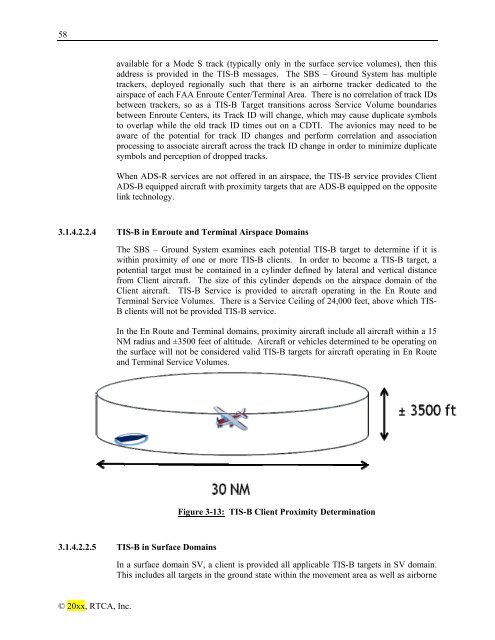Minimum Aviation System Performance Standards for Aircraft ...
Minimum Aviation System Performance Standards for Aircraft ...
Minimum Aviation System Performance Standards for Aircraft ...
You also want an ePaper? Increase the reach of your titles
YUMPU automatically turns print PDFs into web optimized ePapers that Google loves.
58<br />
© 20xx, RTCA, Inc.<br />
available <strong>for</strong> a Mode S track (typically only in the surface service volumes), then this<br />
address is provided in the TIS-B messages. The SBS – Ground <strong>System</strong> has multiple<br />
trackers, deployed regionally such that there is an airborne tracker dedicated to the<br />
airspace of each FAA Enroute Center/Terminal Area. There is no correlation of track IDs<br />
between trackers, so as a TIS-B Target transitions across Service Volume boundaries<br />
between Enroute Centers, its Track ID will change, which may cause duplicate symbols<br />
to overlap while the old track ID times out on a CDTI. The avionics may need to be<br />
aware of the potential <strong>for</strong> track ID changes and per<strong>for</strong>m correlation and association<br />
processing to associate aircraft across the track ID change in order to minimize duplicate<br />
symbols and perception of dropped tracks.<br />
When ADS-R services are not offered in an airspace, the TIS-B service provides Client<br />
ADS-B equipped aircraft with proximity targets that are ADS-B equipped on the opposite<br />
link technology.<br />
3.1.4.2.2.4 TIS-B in Enroute and Terminal Airspace Domains<br />
The SBS – Ground <strong>System</strong> examines each potential TIS-B target to determine if it is<br />
within proximity of one or more TIS-B clients. In order to become a TIS-B target, a<br />
potential target must be contained in a cylinder defined by lateral and vertical distance<br />
from Client aircraft. The size of this cylinder depends on the airspace domain of the<br />
Client aircraft. TIS-B Service is provided to aircraft operating in the En Route and<br />
Terminal Service Volumes. There is a Service Ceiling of 24,000 feet, above which TIS-<br />
B clients will not be provided TIS-B service.<br />
In the En Route and Terminal domains, proximity aircraft include all aircraft within a 15<br />
NM radius and ±3500 feet of altitude. <strong>Aircraft</strong> or vehicles determined to be operating on<br />
the surface will not be considered valid TIS-B targets <strong>for</strong> aircraft operating in En Route<br />
and Terminal Service Volumes.<br />
3.1.4.2.2.5 TIS-B in Surface Domains<br />
Figure 3-13: TIS-B Client Proximity Determination<br />
In a surface domain SV, a client is provided all applicable TIS-B targets in SV domain.<br />
This includes all targets in the ground state within the movement area as well as airborne
















